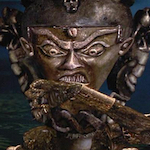
 July 1st, 1994
July 1st, 1994
THE SHADOW is another weird 1994 would-be blockbuster that I previously wrote about in my 2017 series Summer Flings, and I will point you to that review for a more thorough accounting of its plot, merchandising and promotion. But it’s a movie I’m pretty fond of and it’s at least trying to be one of the more traditional popcorn movies of the summer so I wanted to revisit it and discuss it in the context of this retrospective.
You know, when I look at it now the math kinda makes sense. Old pulp super hero + the period when studios were trying to recreate the magic of BATMAN 1989 + Russell Mulcahy, the pioneering music video director who gave us HIGHLANDER and HIGHLANDER II: THE QUICKENING = this movie. It has all kinds of the old timey concepts and tone that I enjoy, it’s filmed with enthusiastic style and energy, it also has a bit of a craziness that’s appealing to me but maybe a turn off for the kind of wide audience they were obviously hoping for. It’s not as wild or messy as THE QUICKENING but it has enough of that that it’s not surprising it didn’t catch on.
(It did open above the other new releases – BLOWN AWAY, I LOVE TROUBLE, BABY’S DAY OUT and LITTLE BIG LEAGUE, but below THE LION KING‘s third week. Then it dropped to #5 the next week.)
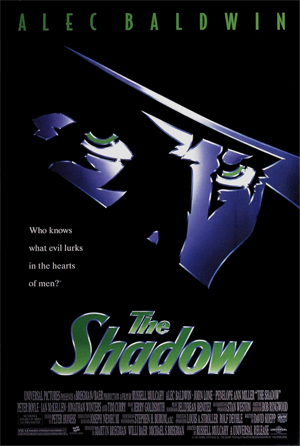 Every time I watch the opening I can imagine it peeling off unadventurous viewers at the same time it’s making me think “Holy shit, this is amazing!” They came to see Alec Baldwin (THE HUNT FOR RED OCTOBER) playing a super hero in a black fedora and long coat, but the fucking thing starts at a palace in Tibet, where he’s an evil opium lord with long hair and fingernails sitting on a throne surrounded by ladies and servants and hangers-on, calling himself “Yin-Ko.” To this day I’m unclear how New York City rich boy Lamont Cranston ended up living this Jabba the Hutt lifestyle for seven years after the war. The villain, Genghis Khan descendant Shiwan Khan (John Lone, YEAR OF THE DRAGON) later says he idolized him for his savagery, marveling about some legendarily brutal raid on a village he once did. Much later Cranston’s love interest Margo Lane (Penelope Ann Miller, DEAD BANG) wakes him from a flashback dream where he’s in armor on horseback chopping people up with a sword, and she says “Whatever you were, whatever you did – it’s in the past.” Man, talk about unconditional love and acceptance!
Every time I watch the opening I can imagine it peeling off unadventurous viewers at the same time it’s making me think “Holy shit, this is amazing!” They came to see Alec Baldwin (THE HUNT FOR RED OCTOBER) playing a super hero in a black fedora and long coat, but the fucking thing starts at a palace in Tibet, where he’s an evil opium lord with long hair and fingernails sitting on a throne surrounded by ladies and servants and hangers-on, calling himself “Yin-Ko.” To this day I’m unclear how New York City rich boy Lamont Cranston ended up living this Jabba the Hutt lifestyle for seven years after the war. The villain, Genghis Khan descendant Shiwan Khan (John Lone, YEAR OF THE DRAGON) later says he idolized him for his savagery, marveling about some legendarily brutal raid on a village he once did. Much later Cranston’s love interest Margo Lane (Penelope Ann Miller, DEAD BANG) wakes him from a flashback dream where he’s in armor on horseback chopping people up with a sword, and she says “Whatever you were, whatever you did – it’s in the past.” Man, talk about unconditional love and acceptance!
I shouldn’t be making assumptions. For all I know, mainstream audiences enjoyed all this weirdness but understandably lost interest when the movie loses some of its steam in the long battle between the rival mind power students of the same tulku (Brady Tsurutani, COME SEE THE PARADISE). Or maybe everyone who saw it kind of liked it but it just didn’t do well because not enough people bought tickets in the first place. I can only speculate. What I do know is that I really love a movie that trusts its audience with this kind of non sequitur. Here’s A, now here’s B, it’s more interesting for you to puzzle over what the fuck kind of dotted line could possibly connect them than for us to draw it for you.
After the prologue is what also would’ve been a cool opening where Lamont materializes as the guy promised on the poster. A group of gangsters are about to dump a scientist (Sab Shimono, BLIND DATE, SUTURE, last seen as the villain in 3 NINJAS KICK BACK) off a bridge, but they’re stopped by The Shadow. With his control over men’s minds he becomes invisible to them, his perfect narrator voice echoing from different directions, surrounding them, still seeming disembodied even when they can see who it’s coming from: a hat, a cloak, a red scarf covering the bottom half of a face, which has Baldwin’s eyes but is basically sculpted in latex to look like The Shadow as he appeared in the painted magazine covers. (The makeup is by the great Greg Cannom, EXORCIST III, HIGHLANDER II, KICKBOXER 2, BRAM STOKER’S DRACULA.)
Then we meet Lamont in his daily life, passing himself off as a handsome bachelor going to fancy restaurants and shit, and right away we see him having to control people’s minds in public. Suddenly a shadow comes across his face, and he tells people what he needs them think, like a Jedi mind trick. Wherever he is – indoors, outdoors – a dramatic shadow can cover his eyes, or everything but his eyes. It’s so cool. The bizarre Tibet opening, followed by the ghostly assault on the foggy bridge, followed by him brainwashing the police chief out in the open makes it feel like a comic book blockbuster set in the dream world.
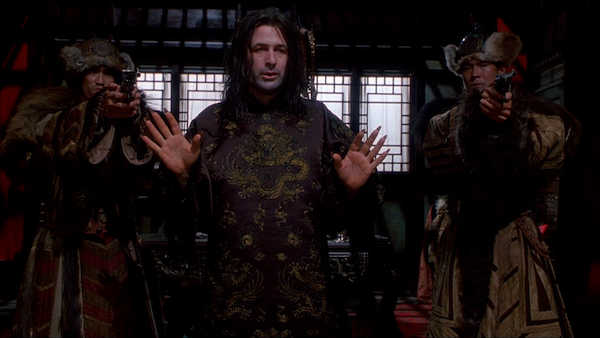

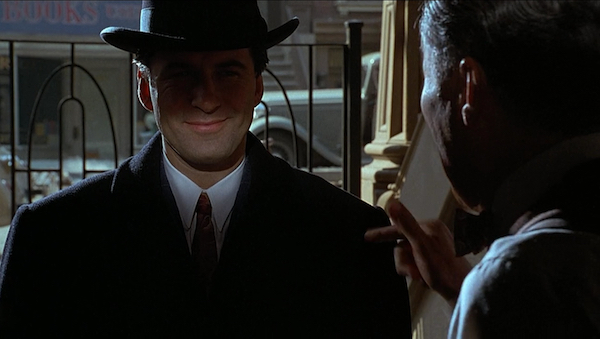
To be technical, THE SHADOW is not a comic book movie, because the character comes originally from a radio show, then pulp magazines. But he’s definitely a super hero, was one of the primary influences on Batman, and therefore comic books, and this certainly belongs in the same genre as BATMAN. So it’s the second comic book movie of summer ’94, coming about a month and a half after THE CROW, which according to Box Office Mojo had only left theaters a week before this came out.
At the time I thought of those two as kind of opposites – THE CROW was the dark, broody comic book movie and THE SHADOW was jokey and joyfully hokey. Those differences remain, but as the genre has evolved and dropped some of its former trappings they seem to have more in common than they used to. In particular, they both follow the rule that the look and atmosphere of the city the character resides in is as important as the costume, the origin, etc. This ‘40s New York City, created with both sets and beautiful matte paintings, is almost as stylized and exaggerated as the ‘90s Detroit of THE CROW. Furthermore, these are both urban crime stories where the protagonist has scary supernatural powers and taps into his dark side to fight a deranged magic user. So yes, I have decided that THE SHADOW, THE CROW, and of course BABY’S DAY OUT take place in the same universe, just different cities and times.
Another way my perception of THE SHADOW has changed in 30 years is similar to THE FLINTSTONES – at the time it seemed very modern because of some computer generated effects, but now it seems classical and old fashioned with its many noticeable matte paintings and giant sets. And I’m guessing most of those cool shadow shots were traditionally animated. Some other fun gimmicks in this one:
-Bad guys see him only as a shadow moving across a wall, they shoot arrows into it, he emerges out of the shadow in three dimensions with the arrows merely pinning his cape to the wall.
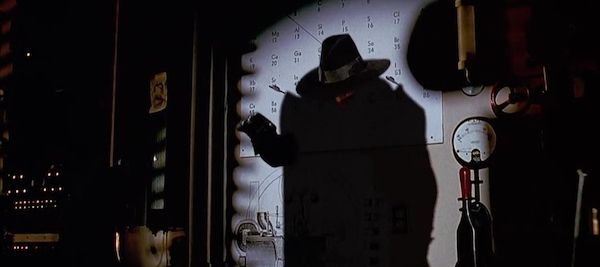
-He and Khan try to shoot each other, but the bullets collide in the air, smashing like cars crashing head on.
-Margo dreams of Lamont digging his fingers into his face, tearing it off and revealing Khan’s underneath.
-Khan is offended by a sailor’s xenophobic comment, and causes him to jump off the Empire State Building. From a distance we see the tiny body plummeting and bouncing as the camera settles on Lamont and Margo walking down the street, having no idea this just happened behind them.
-A showdown in a hall of mirrors that all explode at once – kind of an echo of the shattering glass at the end of HIGHLANDER, though it doesn’t look as beautiful.
The big CG gimmick is the tulku’s dagger that has a face on it and comes to life a couple times. At the time it was a selling point, which is funny because looking at it now it could’ve been done almost the same, and a little better, with stop motion. And I would’ve been just as excited about that.
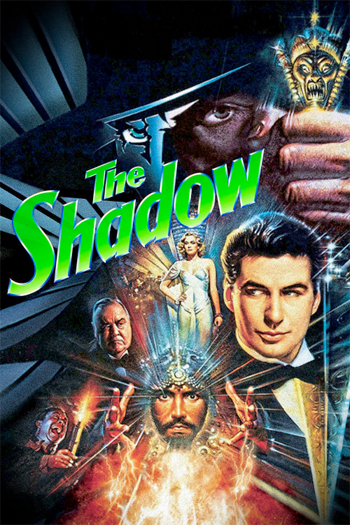 I still really appreciate the tone of the movie, treating all of this stuff seriously but with funny dialogue. Lamont has many dry comments underplaying the situations he’s in, like when he’s sitting down to dinner with Khan and says, like it’s just occurring to him, “By the way – you sent Margo Lane to kill me!” Or when the magic dagger from his past tries to bite him and he says, “Oh— that knife.” Or during the climax when Margo’s father asks her what’s going on and she says, “Well, there’s this guy— I’ll tell you later.”
I still really appreciate the tone of the movie, treating all of this stuff seriously but with funny dialogue. Lamont has many dry comments underplaying the situations he’s in, like when he’s sitting down to dinner with Khan and says, like it’s just occurring to him, “By the way – you sent Margo Lane to kill me!” Or when the magic dagger from his past tries to bite him and he says, “Oh— that knife.” Or during the climax when Margo’s father asks her what’s going on and she says, “Well, there’s this guy— I’ll tell you later.”
There’s no pretension that this is a deep or meaningful movie, but I realize now there are things you can read into its concept that “the clouded mind sees nothing.” It kind of works as a similar metaphor to the one in THE MATRIX. It’s the idea that we can go through the motions of our daily lives, not paying enough attention to observe the powerful people telling us how to think, what to do. Khan makes plans for world domination from a luxury hotel in the middle of downtown, so unnoticed that the building is literally invisible to the people walking past it. Even the funny joke of the museum security guard seeing the armored Khan emerge from Genghis Khan’s magically opening crypt and telling him “W-we’re closed” fits this reading. When Khan asks him to “Join me” the guard’s response is “This is private property.” He sees something incredible but he still can’t conceive of life outside of the existing rule book.
Of course, the MATRIX series ultimately disavows the notion of a chosen one, emphasizing the importance of collective action, while THE SHADOW is in that ‘30s tradition of one particularly great rich guy going out of his way to help people – an increasingly fantastical notion these days, though some love to pretend it’s real. A cool thing about The Shadow’s version of the fantasy is his network of spies and agents made up of people he once helped. They realize they benefit from The Shadow’s system and should help spread the wealth to others.
So I continue to enjoy THE SHADOW. It’s not perfect, and not my favorite of the old timey super hero flops. I always find myself much more invested in all the set up than in the third act battle that pays it off. But by that point it has me hypnotized with its whole world and style and humor. Maybe nobody thought so at the time, but to me its a step toward redeeming this so-far pretty iffy summer movie season.
* * *
post-scripts:
1. It’s cool that the first people we see in the movie are Al Leong, Gerald Okamura and James Hong.
2. This is a good movie for games where you connect different movies through their casts, because in addition to the actors already mentioned you have Peter Boyle, Ian McKellen, Tim Curry, Jonathan Winters, Andre Gregory, and Max Wright from ALF.
3. This time I did notice the Kenny G song playing in The Cobalt Club. What the hell? I still adore the Taylor Dane/Jim Steinman end credits song “Original Sin,” though. This was the summer before I started working at a theater, but that’s one I would’ve enjoyed cleaning.
4. You know this movie means business because it has the production designer of TERMINATOR 2: JUDGMENT DAY (Joseph C. Nemec III), the d.p. of THE OUTSIDERS, RUMBLE FISH and several DePalma movies (Stephen H. Burum), and the editor of HELL UP IN HARLEM (Peter Honess).


























July 9th, 2024 at 7:40 am
This was always my least favorite of this era’s old-timey pulp superhero-y movies, but that didn’t stop me from reading the novelization and playing with the action figures. I think my main issue was my expectation going in– something more grounded like Batman by way of Dick Tracy– and what it turned out to be, with this weird psycho-mystic stuff. But I’m more of a Mulcahy fan now and I should revisit.
Per your previous review, I also find it funny that the full Shadow makeup just makes Alec Baldwin look like Billy Baldwin.